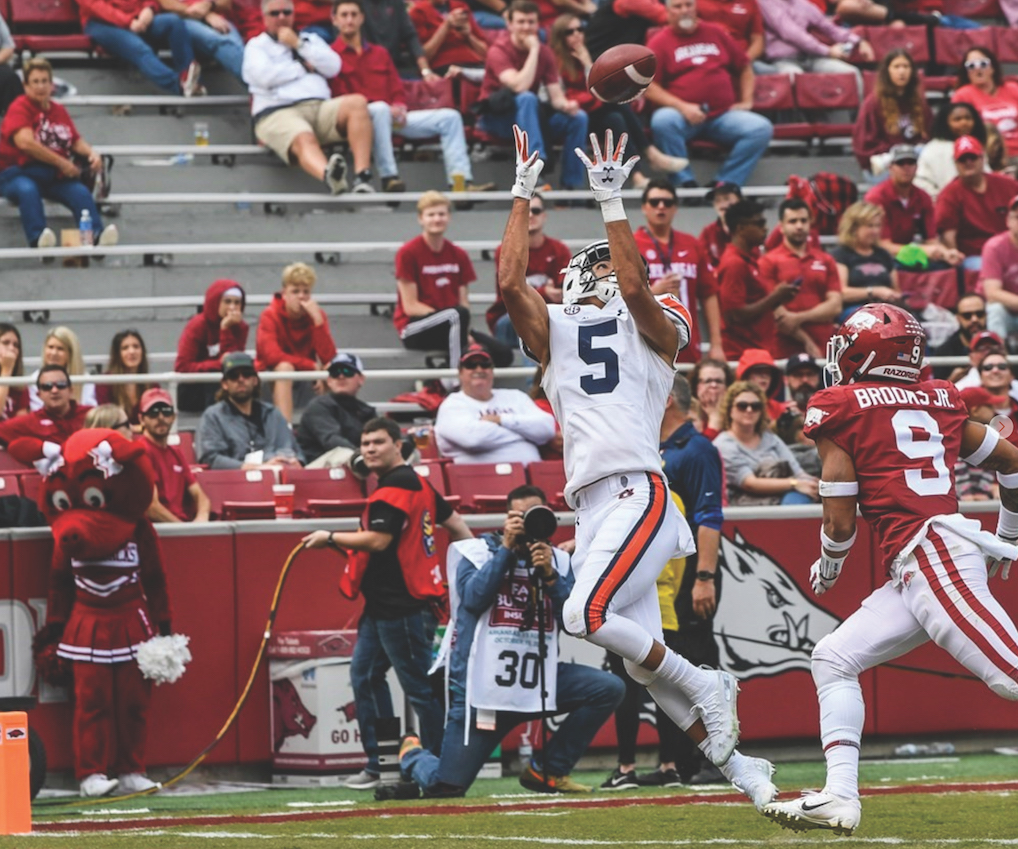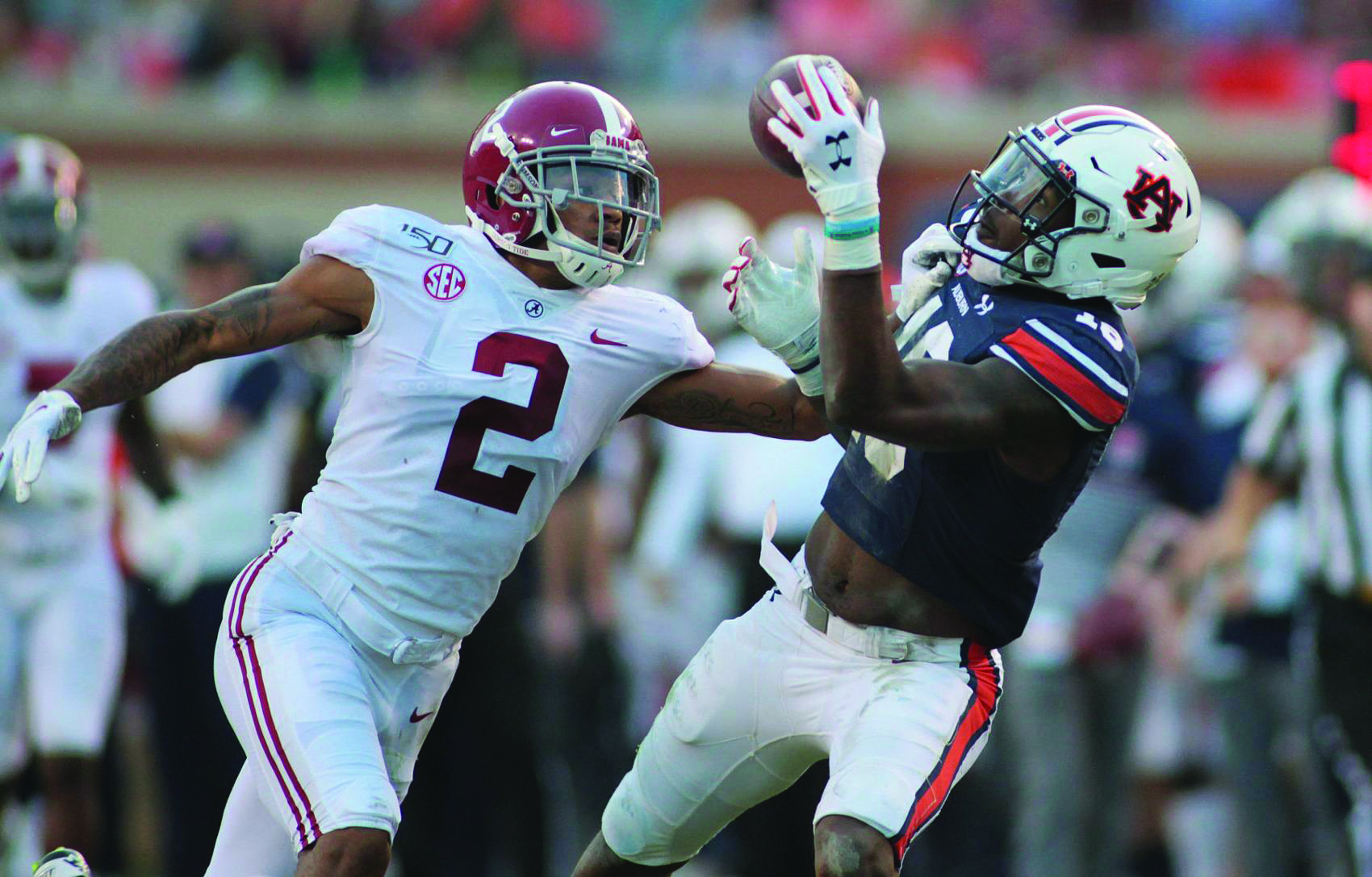Michael Zabala, assistant professor in the Department of Mechanical Engineering, will never forget scoring his first touchdown. It was Sept. 21, 2019, and he was in his living room recliner. The game had just started.
Auburn’s Anthony Schwartz took the reverse all the way — 57-yards. Zabala’s two little girls shouted. His wife hugged him. His phone vibrated with congratulations, not just from his students in the biomechanics group text, but from Dr. Michael Goodlett, the team physician, there on the Auburn sideline in College Station.
“AU ENGINEERING!!!”
It was awesome. But when star receiver Seth Williams caught a touchdown pass early in the third quarter, shaking off a goal line hit to his injured left shoulder as if he hadn’t even felt it — that’s when it felt official: Zabala’s cutting-edge work in the Auburn University Biomechanical Engineering (AUBE) lab on the third floor of Wiggins Hall was now, literally, a game-changer.
Auburn 28 – Texas A&M 20.
Zabala smiles.
“I thought, ‘that’s as close as I’ll ever get to scoring a touchdown,’” he said. “It was like Auburn biomechanics scored 14 points that day.”
Zabala graduated from Auburn in mechanical engineering in 2007 and, after earning a master’s and doctorate from Stanford University, returned to his alma mater in 2016 to teach. He’s a huge Auburn football fan. Has been for a while. Two years ago, when filming a video promoting his work in motion capture, he could have demonstrated the technology using a student. Instead, he stuck all the sensors on Aubie, the university’s mascot.
So when duty called while he was heating up a leftover barbecue sandwich for lunch the Monday before Auburn’s season opener against Oregon, he answered.
It was his neighbor, Robbie Stewart.
Stewart laughs.
“Yeah, I definitely think he was excited to contribute to what we wanted to do.”
Stewart, Auburn football’s head athletics trainer, first got the idea in 2018, when he heard about a custom elbow brace Purdue engineers had crafted for a Boilermaker basketball standout. It sounded like some of the stuff his neighbor worked on — orthotics and the musculoskeletal study of athletes and injury prevention. Could he involve Zabala in helping Auburn players get back on the field faster?
The possibility stayed in the back of his mind for a year. In early August, it moved to the front. Sophomore wide receiver Anthony “Flash” Schwartz, the fastest man in college football, had broken his hand. Stewart picked up the phone.

It wasn’t as if the trainers had never made a custom brace for a player. They’d made plenty. But you can only do so much with molds. You can only make them so fast. You can only make them fit so well.
“He didn’t really know how we could do it,” Zabala said. “He thought it would be carbon fiber, but he just asked if we could make Schwartz a more customized brace for his hand, and if we could make it quickly.”
The timing — and the results — couldn’t have been better.
In the summer of 2018, right around the time Stewart first envisioned future collaborations with the engineer next door, Zabala and an interdisciplinary group of Auburn engineers and scientists were designated a Tier III team in Auburn University’s Presidential Awards for Interdisciplinary Research (PAIR) program and assigned nearly $1.275 million in research funding over three years.
The title of their winning proposal? “Additive Manufacturing of Durable, Next Generation Implants and Orthotics.”
Forget plaster molds and carbon fiber, Zabala told Stewart. Thanks to a new Creaform scanner purchased for the PAIR project, Zabala could take a spool of polylactic acid and 3-D print Schwartz a thin, durable brace that would fit so perfectly like a glove that he could put it under his glove without anyone else on the field even knowing it was there.
Stewart said to go for it.
The next day, the AUBE lab students met Schwartz at the door. They flipped on the scanner. Zabala observed.
He hid it well, but he was giddy. It was almost too good to be true. Up until that point, his team had only scanned a horse hoof. Now, he not only had an opportunity to contribute to Auburn football, he had exactly the sort of test subject he was looking for. He couldn’t have asked for a better PAIR project case study than Anthony Schwartz …
… except maybe for the next player to come to the lab.

Schwartz’s first brace took two days to print. For the first couple of games, he still wore a cast. Goodlett said the hand hadn’t completely healed. But as soon as Stewart and Goodlett saw the brace perform in practice, they reached back out and asked Zabala to again wave his magic, $45,000 3-D wand, this time over Williams.
Williams finished the 2019 regular season with 891 yards on 55 catches, eight of those for touchdowns. He was Auburn’s leading receiver by a mile. Without the AUBE Lab, it would have been different story.
A week after making the amazing, game-winning touchdown grab in Auburn’s season-opener against Oregon, Williams injured his left shoulder against Tulane. Senior athletics trainer Kirk Nielson walked him over to Wiggins Hall the following Monday, had Williams take off his shirt, grabbed a Sharpie and drew an outline of exactly where he wanted the brace to sit on Williams’ shoulder. He decided to extend the design over Williams’ chest to protect his ribs.
The Creaform GoScan is sensitive enough to add dimension to tattoos. Newly applied Sharpie was no problem.
“Because the scanner is so advanced, it’s able to pick up the texture of the skin as well as the volume of the skin to within .1 mm of accuracy,” said mechanical engineering doctoral student and Presidential Graduate Research Fellow Jake Larson. “We go through the scanned 3-D model of whatever we’re interested in and highlight the region of the body that we want to cover. The Sharpie shows up in the scanned model and gives me a reference on how we choose to create the shell that we print.”
Larson was more of an NFL guy before coming to Auburn. But ever since mid-September, all he can think about is Saturday getting here, and about getting in front of a TV.
He just has to make sure he has a charger nearby.
The biomechanics group text keeps blowing up his phone with exclamation points, mostly from Dr. Zabala, but all the guys working on Project Body Armor chime in. That’s what they call it — Body Armor. That’s the name of the folder they save all the files in. “AS Hand. SW Shoulder.”
“We joke and tell them they have to score if we scan them,” Larson said. “They both laughed and then scored the first week they wore it.”
Schwartz’s first touchdown with the brace, the 57-yard run early against Texas A&M, was the first he’d scored all season, and only the second time he’d touched the ball. The first pass thrown his way came two weeks earlier, in the Tigers’ home opener against Tulane. He had a step on the defender. The pass was on target.
The ball bounced off his cast. Incomplete.
“The custom fit piece has been a big help,” Schwartz said.
“It’s better than having a big cast on my hand because I can actually catch the ball.”
With the brace, Schwartz’s stats soared. He finished the regular season as Auburn’s second-leading receiver with 391 yards on 35 catches.
But the ultimate test for Project Body Armor may have come in the Mississippi State game.
It was brutal.
Late in the second quarter, Bulldogs linebacker Erroll Thompson drilled the crown of his helmet into the upper left chest of an unsuspecting Seth Williams after a rare dropped pass. The crowd gasped. Williams went flying. Thompson was ejected.
Zabala was relieved.
The hit looked to be directly to the portion of the brace that Stewart and Nielson designed to extend to Williams’ ribs for extra protection. Still, Zabala expected to see Williams on the ground, clutching his shoulder. He expected to see Stewart and Goodlett jogging toward him to help him off the field.
Instead, Williams immediately popped up, seemingly no worse for the wear. Zabala was amazed.
“I texted Kirk Nielson the next day to see if Seth was okay and to check on the brace to see if it was even still intact.”
The brace was fine.
Williams was fine — and grateful.
So was Goodlett.

“I was glad he had that on, for sure,” Goodlett said. “The hit couldn’t have been more directly to the place he was hurt. If we didn’t have that one piece, we would have had two different pads and I don’t think they would have protected him nearly as well. The brace obviously worked like a charm.”
So have the others. The Monday after the Mississippi State game, Zabala got another call from the athletics complex. Another player came to be scanned. Then another.
In early October, Zabala ordered another 3-D printer to keep up with the demand. And the repeat business.
For the Oct. 19 Arkansas road game, the lab printed another, even smaller brace for Schwartz, though Zabala wasn’t sure if it Schwartz would use it. After the game, sportswriters reported that he didn’t — that Flash was back, finally playing without any protection on his hand beyond a glove. The stats seemed to back that up.
Auburn’s 51-10 win was the best game of Schwartz’s career.
He ran the ball twice for 30 yards and logged 73 yards on six catches, one for a touchdown late in the third quarter.
That’s when Zabala’s phone began buzzing. It wasn’t the biomechanics group text. It was Goodlett again, this time from Fayetteville.
“AU ENGINEERING!!!”